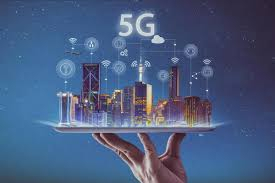What is the difference between H+, LTE, 4G and 3G?
You’ve probably noticed that, next to your signal strength indicator on your phone, sometimes the letters and symbols have changed – along with the speed of your internet.
This is because there's a range of mobile networks available from GPRS to 5G, and you’re only able to access each network in certain places.
See below what these network symbols mean and how this affects how well your phone performs.
GPRS
GPRS (Global Packet Radio Service) was the first widely used network connection accessed by mobile phones using GSM, which stands for Global System for Mobile Communications - the system a SIM card uses to connect to a digital mobile network.
When you’re connected to this network, you’ll see the G symbol next to your network bars. It’s the slowest of all networks – your phone will only use GPRS as a last resort, so you probably won’t see the G symbol often.
It’s used for WAP (internet browsing) and MMS (multimedia messaging, such as sending pictures or videos over text) and typically reaches speeds around 40 Kbit/s. Although, in theory, GPRS could reach up to 115 Kbit/s, it’s unlikely it would ever exceed 50 Kbit/s at most, meaning you wouldn’t be able to use internet data with this network, and would likely struggle to send texts quickly or have a quality phone call.
E
You’ll see the E symbol when your phone is using Enhanced Data Rates for GSM Evolution, which is also known as Enhanced GPRS.
This is the second slowest mobile network, and it’s usually the last network a modern smartphone will connect to.
You’ll typically see speeds around 400 Kbit/s, which is significantly faster than GPRS but still isn’t fast enough to browse the internet. Texts will send slightly quicker and calls are more likely to connect though.
3G
3G simply means 3rd Generation. It’s faster than mobile connections before it and uses UMTS, which stands for Universal Mobile Telecommunications Service – it’s the third-generation mobile cellular system for mobile networks based on GSM technology.
3G runs from 384 Kbit/s to 42 Mbit/s (42,000 Kbit/s). Depending on the strength of your signal, you should be able to use the internet quite easily, it may just be a little slow at times.
Many smartphones access this network, especially when faster or newer networks aren’t available in the immediate vicinity.
H/H+
Your device is using High Speed Packet Access when you see the H symbol. This is still a very common network and most smartphones connect to it regularly when newer networks aren’t available.
You should be able to browse the internet and stream audio/video on this network, without many issues, thanks to its 7 Mbit/s speed. Texts and calls will usually be fine, but you probably won’t be able to download a film or any large file in a reasonable amount of time.
However, H continued to evolve, becoming H+. H+ can usually provide really decent speeds of up to an impressive 168 Mbit/s – a big improvement from the original H speeds.
Using H+, you’ll probably be able to use your phone as normal in terms of internet, text and call usage – you just might notice the speed is slightly slower than 4G.
4G/LTE
The 4th Generation of mobile technology, or 4G, uses Long Term Evolution (LTE), which is the upgraded version of UMTS. As of now – before 5G is widely rolled out – it’s the best network your phone can use.
With speeds of up to 1 Gbit/s, this network allows your mobile internet to function just as quickly – if not quicker in some cases – than Wi-Fi. You typically won’t have any problems surfing the web, streaming videos in high definition (HD), or downloading and uploading data at any point.
5G
It’s impossible to say definitely how fast the 5th Generation LTE network will be, as it’s still in its very early stages and hasn’t been trialled publicly yet. However, providers have hypothesised that the network would be able to provide download speeds up to 1000 times faster than 4G.
This means that your phone network would be faster than your Wi-Fi network – and it could handle more devices accessing its network at the same time, too.
Therefore, I would suggest
#Telebirr users to apply for 4G or 5G network or buy phones that support 3G H+ to help them surf internet fastly.
Furthermore, I would advise Ethiotelecom to expand 4G network to more areas including woredas for fast and genuine internet usage.
What is the difference between H+, LTE, 4G and 3G?
You’ve probably noticed that, next to your signal strength indicator on your phone, sometimes the letters and symbols have changed – along with the speed of your internet.
This is because there's a range of mobile networks available from GPRS to 5G, and you’re only able to access each network in certain places.
See below what these network symbols mean and how this affects how well your phone performs.
GPRS
GPRS (Global Packet Radio Service) was the first widely used network connection accessed by mobile phones using GSM, which stands for Global System for Mobile Communications - the system a SIM card uses to connect to a digital mobile network.
When you’re connected to this network, you’ll see the G symbol next to your network bars. It’s the slowest of all networks – your phone will only use GPRS as a last resort, so you probably won’t see the G symbol often.
It’s used for WAP (internet browsing) and MMS (multimedia messaging, such as sending pictures or videos over text) and typically reaches speeds around 40 Kbit/s. Although, in theory, GPRS could reach up to 115 Kbit/s, it’s unlikely it would ever exceed 50 Kbit/s at most, meaning you wouldn’t be able to use internet data with this network, and would likely struggle to send texts quickly or have a quality phone call.
E
You’ll see the E symbol when your phone is using Enhanced Data Rates for GSM Evolution, which is also known as Enhanced GPRS.
This is the second slowest mobile network, and it’s usually the last network a modern smartphone will connect to.
You’ll typically see speeds around 400 Kbit/s, which is significantly faster than GPRS but still isn’t fast enough to browse the internet. Texts will send slightly quicker and calls are more likely to connect though.
3G
3G simply means 3rd Generation. It’s faster than mobile connections before it and uses UMTS, which stands for Universal Mobile Telecommunications Service – it’s the third-generation mobile cellular system for mobile networks based on GSM technology.
3G runs from 384 Kbit/s to 42 Mbit/s (42,000 Kbit/s). Depending on the strength of your signal, you should be able to use the internet quite easily, it may just be a little slow at times.
Many smartphones access this network, especially when faster or newer networks aren’t available in the immediate vicinity.
H/H+
Your device is using High Speed Packet Access when you see the H symbol. This is still a very common network and most smartphones connect to it regularly when newer networks aren’t available.
You should be able to browse the internet and stream audio/video on this network, without many issues, thanks to its 7 Mbit/s speed. Texts and calls will usually be fine, but you probably won’t be able to download a film or any large file in a reasonable amount of time.
However, H continued to evolve, becoming H+. H+ can usually provide really decent speeds of up to an impressive 168 Mbit/s – a big improvement from the original H speeds.
Using H+, you’ll probably be able to use your phone as normal in terms of internet, text and call usage – you just might notice the speed is slightly slower than 4G.
4G/LTE
The 4th Generation of mobile technology, or 4G, uses Long Term Evolution (LTE), which is the upgraded version of UMTS. As of now – before 5G is widely rolled out – it’s the best network your phone can use.
With speeds of up to 1 Gbit/s, this network allows your mobile internet to function just as quickly – if not quicker in some cases – than Wi-Fi. You typically won’t have any problems surfing the web, streaming videos in high definition (HD), or downloading and uploading data at any point.
5G
It’s impossible to say definitely how fast the 5th Generation LTE network will be, as it’s still in its very early stages and hasn’t been trialled publicly yet. However, providers have hypothesised that the network would be able to provide download speeds up to 1000 times faster than 4G.
This means that your phone network would be faster than your Wi-Fi network – and it could handle more devices accessing its network at the same time, too.
Therefore, I would suggest #Telebirr users to apply for 4G or 5G network or buy phones that support 3G H+ to help them surf internet fastly.
Furthermore, I would advise Ethiotelecom to expand 4G network to more areas including woredas for fast and genuine internet usage.







